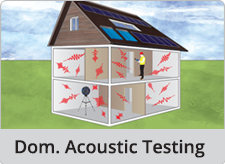Offices Nationwide
• Glasgow
• Newcastle
• Manchester
• Portsmouth
• Wakefield
• Sheffield
• Birmingham
• Wrexham
• Cardiff
• Peterborough
• Milton Keynes
• London
• Plymouth
• Anglesey
• Glasgow
• Newcastle
• Manchester
• Portsmouth
• Wakefield
• Sheffield

How loud is too loud?
Noise above 85 dBA over time will cause hearing loss. In general, the louder the noise, the less time required before hearing loss...more

Sound Insulation
Two parameters describe sound insulation; Dw and Rw. Dw is the insulation between rooms. Rw is the lab-tested insulation of a wall/floor...more
Stanford Bridge - Room Integrity Testing - 0121 381 0129
The office that covers this area is: Birmingham
Phone Number: 0121 381 0129 Email: stanford-bridge@e2consultants.co.uk
Our other services include:
Room Integrity Testing can also be known as:
Fire Suppression Testing, Fire Suppression Room Integrity Testing, Server Room Testing,


Copyright 2025 E2 Specialist Consultants Limited
Company No. 06728970









































